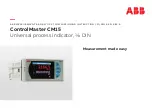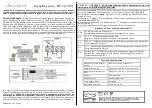
DOL 834 CE
8
Technical User Guide
2 Product description
DOL 834 is a house controller developed for insect farming systems with a focus on the soldier fly and meal-
worms. It is thus intended for breeding and growth of larvae and pupae, but can be adapted to most types of in-
sect farming systems.
Insect farming is an intensive form of production. The insects generate a lot of heat, just like the level of CO
2
and NH
3
can be high in relation to the room. It requires efficient ventilation with high and uniform air change en-
suring good production conditions throughout the insect house.
DOL 834 meets the insects' special needs for climate control with recirculation, humidification, ventilation boost
and curve control, which is performed on an hourly basis. The ventilation can be controlled as an equal pressure
system and as a central exhaust system.
The house controller is available in two variants, both of which are used in a total insect ventilation system:
• DOL 834 Insect (section ventilation)
• DOL 834 CE Insect (central exhaust)
The climate controller is operated via a touch display with graphical views of e.g. the ventilation status, icons
and curves. Page views may be adapted in accordance with the user requirements so that the most frequently
used working procedures are easily accessible.
Nursery, grow-out and pupa house
Central exhaust - fan bank
DOL 834 CE insect
Air outlet
DOL 834 insect
Air inlet
DOL 834 insect
Recirculation unit
DOL 834 insect
Air inlet
DOL 834 CE insect
Figure 1: Ventilation components in an insect house with grow-out crates
In production systems for soldier flies, humidity control and removal of humidity with the ventilation air is crucial
in pupa, nursery and growth sections. The flies are produced here in a moist substrate, and the heat production
of the larvae is released especially in the form of water vapor.
During the growth-out period, the moisture content of the substrate changes. Typically, the substrate has a dry
matter content of approx. 30 % at the start, while at the end it must have a dry matter content of 50-60 %. Dur-
ing the production it is important to maintain such a high moisture content in the substrate that the larvae can
eat the dry matter. The larvae have no teeth and therefore they have to suck in the food. Likewise, it must be
avoided that the surface dries out, as this can make the substrate inaccessible to the larvae, and cause it to
form cakes/crusts, which will be sieved off together with the larvae at the end of production. At the end, it must
be so dry that the larvae can be sieved from the frass. See the section about Humidity.
Summary of Contents for DOL 834 CE
Page 2: ......









































